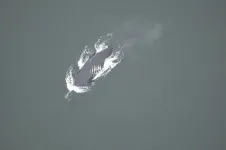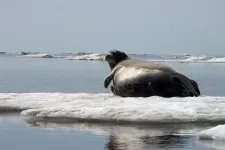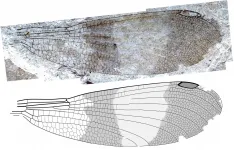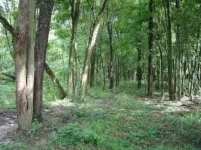After Hurricane Irma, soundscape reveals resilient reef ecosystem
2021-02-24
(Press-News.org) A new study from North Carolina State University reveals that the soundscapes of coral reef ecosystems can recover quickly from severe weather events such as hurricanes. The work also demonstrates that non-invasive monitoring is an important tool in shedding further light on these key ecosystems.
Soundscape ecology is a relatively new way for researchers to keep tabs on a variety of habitats without direct interference. In underwater habitats like coral reefs, soundscapes allow continual monitoring of an ecosystem that is difficult to access. By deploying underwater microphones, or hydrophones, researchers can get an acoustic picture of the types of animals in the ecosystem, as well as their behavior patterns.
Kayelyn Simmons, a Ph.D. student at NC State, used soundscapes and underwater mapping to monitor two different reef sites in the Florida Keys from February to December 2017. She deployed and collected eight hydrophones every three months between the two sites: a pristine reef located at Eastern Sambo, and a fishing site located at Western Dry Rocks.
Hurricane Irma struck the Florida Keys as a Category 4 storm in September 2017. Simmons was able to retrieve two of the hydrophones - one from each site - in December. Unfortunately, the hydrophone retrieved from Western Dry Rocks had been compromised by the storm, rendering its post-storm data unusable.
"Prior to the hurricane, we were able to determine what the 'normal' sound patterns were in each habitat, so we knew what the baselines were in terms of species and behavior," Simmons says. "You can tell which species are present based on where their sounds are on the frequency band. Similarly, the amount of noise from each species can give you an idea of their numbers. So the soundscape is a good way to measure abundance and diversity."
Each study site had the same species present. For example, snapping shrimp, with their high frequency "Rice Krispies in milk" popping noises, were active in the periods between dusk and dawn; while grunts, grouper and snapper, with sounds in the lower frequency bands, were mainly active during the day. The hydrophones also captured spawning activity during the full moon.
Simmons analyzed the sound captured by the surviving Eastern Sambo hydrophone and discovered that even though the reef suffered physical damage from the hurricane, the residents and their activity levels began returning to normal approximately 24 to 48 hours after the storm passed.
"The acoustic energy exposure for the reef was as loud as a small boat circling in one spot for two weeks," Simmons says. "So we didn't record any fish noises during the four-day period that Irma came through due to acoustic masking from the storm. However, the snapping shrimp were back to pre-storm sound levels within 24 hours. The fish noises on the lower frequency were back within 72. And on the next full moon we heard normal spawning behavior.
"Overall, the research shows that the coral reef soundscape was resilient and able to recover from the storm quickly."
INFORMATION:
The work appears in PLOS One and was supported by the Coral Reef Conservation Fund (grant NA18NOS4820113) and the National Oceanic and Atmospheric Administration's National Marine Sanctuary Program (grant NFFM7320-19-01243). David Eggleston and Del Bohnenstiehl, both professors of marine, earth and atmospheric sciences at NC State, co-authored the work.
Note to editors: An abstract follows.
"Hurricane impacts on a coral reef soundscape"
DOI: 10.1371/journal.pone.0244599
Authors: Kayelyn Simmons, Dave Eggleston, Del Bohnenstiehl, North Carolina State University
Published: Feb. 24 in PLOS One
Abstract:
Soundscape ecology is an emerging field in both terrestrial and aquatic ecosystems, and provides a powerful approach for assessing habitat quality and the ecological response of sound producing species to natural and anthropogenic perturbations. Little is known of how underwater soundscapes respond during and after severe episodic disturbances, such as hurricanes. This study addresses the impacts of Hurricane Irma on the coral reef soundscape at two spur-and groove fore-reef sites within the Florida Keys USA, using passive acoustic data collected before and during the storm at Western Dry Rocks (WDR) and before, during and after the storm at Eastern Sambo (ESB). As the storm passed, the cumulative acoustic exposure near the seabed at these sites was comparable to a small vessel operating continuously overhead for 1-2 weeks. Before the storm, sound pressure levels (SPLs) showed a distinct pattern of low frequency diel variation and increased high frequency sound during crepuscular periods. The low frequency band was partitioned in two groups representative of soniferous reef fish, whereas the high frequency band represented snapping shrimp sound production. Daily daytime patterns in low frequency sound production largely persisted in the weeks following the hurricane. Crepuscular sound production by snapping shrimp was maintained post-hurricane with only a small shift (~1.5dB) in the level of daytime vs nighttime sound production for this high frequency band. This study suggests that on short time scales, temporal patterns in the coral reef soundscape were relatively resilient to acoustic energy exposure during the storm, as well as changes in the benthic habitat and environmental conditions resulting from hurricane damage.
ELSE PRESS RELEASES FROM THIS DATE:
2021-02-24
NASA's Parker Solar Probe captured stunning views of Venus during its close flyby of the planet in July 2020.
Though Parker Solar Probe's focus is the Sun, Venus plays a critical role in the mission: The spacecraft whips by Venus a total of seven times over the course of its seven-year mission, using the planet's gravity to bend the spacecraft's orbit. These Venus gravity assists allow Parker Solar Probe to fly closer and closer to the Sun on its mission to study the dynamics of the solar wind close to its source.
But -- along with the orbital dynamics -- these passes can also yield some unique and even unexpected views of the inner solar system. During the mission's third ...
2021-02-24
Evolutionary expert Charles Darwin and others recognized a close evolutionary relationship between humans, chimps and gorillas based on their shared anatomies, raising some big questions: how are humans related to other primates, and exactly how did early humans move around? Research by a Texas A&M University professor may provide some answers.
Thomas Cody Prang, assistant professor of anthropology, and colleagues examined the skeletal remains of Ardipithecus ramidus ("Ardi"), dated to 4.4 million years old and found in Ethiopia. One of Ardi's hands was exceptionally well-preserved.
The researchers compared the shape of Ardi's hand to hundreds of other hand specimens representing recent humans, apes and monkeys (measured ...
2021-02-24
A study co-authored by scientists at the New England Aquarium has found that known deaths of critically endangered North Atlantic right whales represent a fraction of the true death toll. This comes as the death of a calf and recent sightings of entangled right whales off the southeastern United States raise alarm.
The study, published this month in END ...
2021-02-24
Ithaca, NY-- During mating season, male bearded seals make loud calls to attract a mate--even their "quiet" call could still be as ear-rattling as a chainsaw. Bearded seals have to be loud to be heard over the cacophony of their equally loud brethren. And, increasingly, the noise humans make is adding to the underwater din and could have serious consequences. A study conducted by the Cornell Lab of Ornithology's Center for Conservation Bioacoustics (CCB) aims to understand how resilient bearded seals can be to changes in ambient underwater noise. The results are published in Proceedings of the Royal Society: Biological Science.
"We wanted to know whether bearded seals would call louder when ...
2021-02-24
Researchers at Stevens Institute of Technology have developed a new machine learning-powered platform, known as OC-SMART, that can process ocean color in satellite images 10 times faster than the world's leading platform. The work, which will be adopted by NASA, is one of the first machine learning-based platforms in ocean color analysis that can process both coastal and open ocean regions globally to reveal data on sea health and the impact of climate change.
The work, led by Knut Stamnes, a physics professor at Stevens, and spearheaded by Yongzhen Fan Ph.D. '16, a visiting physics scholar in Stamnes' lab, solves a 30-year-old problem in retrieving data from both coastal regions and open ocean areas. For decades, NASA's SeaDAS platform exceled at analyzing ocean color ...
2021-02-24
For more than 150 years, scientists have been incorrectly classifying a group of fossil insects as damselflies, the familiar cousins of dragonflies that flit around wetlands eating mosquitoes. While they are strikingly similar, these fossils have oddly shaped heads, which researchers have always attributed to distortion resulting from the fossilization process.
Now, however, a team of researchers led by Simon Fraser University (SFU) paleontologist Bruce Archibald has discovered they aren't damselflies at all, but represent a major new insect group closely related to them.
The findings, published today in Zootaxa, show that the distinctive shape of the insect's non-protruding, ...
2021-02-24
When people hear botulinum toxin, they often think one of two things: a cosmetic that makes frown lines disappear or a deadly poison.
But the "miracle poison," as it's also known, has been approved by the F.D.A. to treat a suite of maladies like chronic migraines, uncontrolled blinking, and certain muscle spasms. And now, a team of researchers from Harvard University and the Broad Institute have, for the first time, proved they could rapidly evolve the toxin in the laboratory to target a variety of different proteins, creating a suite of bespoke, super-selective ...
2021-02-24
A Brazilian study published (http://www.nature.com/articles/s41467-020-20217-w) in Nature Communications shows that human activities have directly or indirectly caused biodiversity and biomass losses in over 80% of the remaining Atlantic Rainforest fragments.
According to the authors, in terms of carbon storage, the biomass erosion corresponds to the destruction of 70,000 square kilometers (km²) of forest - almost 10 million soccer pitches - or USD 2.3 billion-USD 2.6 billion in carbon credits. "These figures have direct implications for mechanisms of climate change mitigation," they state in the article.
Atlantic Rainforest remnants ...
2021-02-24
DALLAS - Feb. 24, 2021 - Using machine learning tools to analyze hundreds of proteins, UT Southwestern researchers have identified a group of biomarkers in blood that could lead to an earlier diagnosis of children with autism spectrum disorder (ASD) and, in turn, more effective therapies sooner.
The identification of nine serum proteins that strongly predict ASD were reported in a study published today by PLOS ONE.
Earlier diagnosis, followed by prompt therapeutic support and intervention, could have a significant impact on the 1 in 59 children diagnosed with autism in the United States. Being able to identify children on the autism spectrum when they are toddlers could make a big difference, says Dwight German, Ph.D., professor of psychiatry at UT Southwestern ...
2021-02-24
For decades, climate change researchers and activists have used dramatic forecasts to attempt to influence public perception of the problem and as a call to action on climate change. These forecasts have frequently been for events that might be called "apocalyptic," because they predict cataclysmic events resulting from climate change.
In a new paper published in the International Journal of Global Warming, Carnegie Mellon University's David Rode and Paul Fischbeck argue that making such forecasts can be counterproductive. "Truly apocalyptic forecasts can only ever be observed in their failure--that is the world did not end as predicted," says Rode, adjunct research faculty with the Carnegie Mellon Electricity Industry Center, "and observing ...
LAST 30 PRESS RELEASES:
[Press-News.org] After Hurricane Irma, soundscape reveals resilient reef ecosystem






